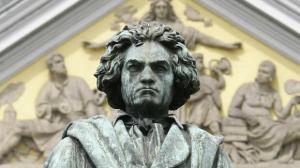Plenty of contemporary art music has ordinary rhythm. There are other approaches, however, that can be used to provide different sorts of rhythmic interest.
Music that seems to be free or only loosely coordinated
One example of this music is the first movement of Olivier Messaien’s Quartet for the End of Time, entitled Liturgy of Crystal. Listen to this music while following the score, noting how each instrument seems to move at its own pace. What aspects coordinate this music? Do instruments seem to align with the meter? Or to each other? Where do you perceive downbeats?
Some music provides extreme freedom in its interpretation, giving little information about how it is to be rhythmically interpreted. For instance, the beginning of Aleksandra Vrebalov’s My Desert, My Rose has performers coordinate by reading from the score (it’s here) until rehearsal letter T [here], at which point the music (more or less) settles into a consistent 7/8 meter.
Music with a propulsive beat
Much music of the 20th and 21st century has a strongly propulsive beat, not unlike some classical music of the past and certainly similar to much rock and jazz. Complex rhythmic patterns can be especially clear when they are accompanied by a persistent groove. The second movement of Béla Bartók’s String Quartet No. 2 is a great example of how small bars (in this case, 2/4) can be combined to make phrases of different lengths with a constant flow of 8th notes providing a rhythmic underpinning.
Music in unbalanced meters
While traditional music tends to be either in simple or compound time, music can also combine aspects of each (for instance in 5/8 meter, in which each bar has one simple beat and one compound, not necessarily in that order) or can shift from one to the other. Returning to Messaien’s Quartet for the End of Time, this approach can be seen in the sixth movement, called Dance of the Furies, for the Seven Trumpets. A tour-de-force entirely in octaves and unisons, notice how bars combine aspects of simple and compound meters (and more complicated rhythms, like beats with five 16th notes), and how Messaien did not even notate meter.
Music can also sound fresh and unpredictable in a consistent meter with an uncommon time signature (like Steve Reich’s Eight Lines in 5/4), or free and flexible in meters that change constantly (like Reich’s Proverb), or this part of Igor Stravinsky’s The Rite of Spring. Another terrific example is #140 (“Free Variations”) from Bartók’s Mikrokosmos.
Tempo fluctuation
Some composers, most notably Elliott Carter (1908-2012), explored the use of metric modulation to move from one tempo to another. Here’s a charming video of a drummer demonstrating the concept. Carter’s music is particularly complicated in this regard because the metric modulations are combined with an existing complexity of rhythm. For instance, in his solo guitar work Shard, a metric modulation in bar 5 uses one sixteenth note of the previous tempo as a single triplet unit in the next. In bar 17, the duration of five 16th notes becomes used as the new quarter note pulse. This continues…
One fantastic online resource is the Metric Modulation Calculator. It helps calculate tempi based on meter changes.
Additive rhythm is a name given to the technique of using flexible lengths for musical fragments, constantly changing the lengths of a particular gesture. This can be reflected in changes of time signatures, or with a consistent time signature (as in Jacob her Veldhuis’ Caterpillar – here is one page of the score).
Polyrhythms
The use of two simultaneous rhythmic “paces” (“polyrhythm“) can provide great rhythmic interest. This can happen through the use of tuplets, like in this segment of the second movement of Charles Ives’ Trio (layering triplets in the cello and the pianists’ right hand against sextuplets and septuplets in the other parts). It can also occur in the layering of different-length patterns that share a beat-division, such as Adam Silverman’s Pounding Fists; notice in this score, starting in bar 5, how a raucous texture is created with repeated ostinati of different lengths (the triangle pattern repeats every two beat, the bell tree every four; the glockenspiel ostinato lasts five eighth-notes; the two vibraphones loop every three eighth-notes; the two marimbas every five sixteenth-notes).













